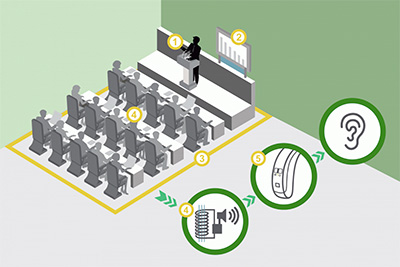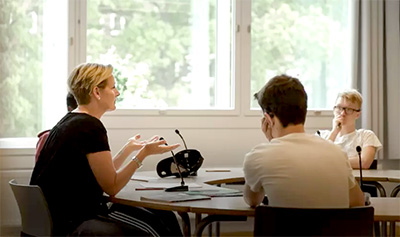With around 1,050 students, Stockholm’s Alvik School hosts students from reception up to Grade 9. With around 120 of its students hard of hearing, the school sought to alleviate any feelings of isolation in the classroom and to ensure that they can hear the teacher and each other clearly.
 Initially conventional wired sound reinforcement systems were tested, but these limited teachers’ flexibility and freedom of movement. Wireless microphones solved this but brought large and obtrusive transmitters to tables during lessons, an ongoing need to check and replace batteries, and the challenge of finding enough available frequencies to allow multiple systems to be used in adjacent classrooms.
Initially conventional wired sound reinforcement systems were tested, but these limited teachers’ flexibility and freedom of movement. Wireless microphones solved this but brought large and obtrusive transmitters to tables during lessons, an ongoing need to check and replace batteries, and the challenge of finding enough available frequencies to allow multiple systems to be used in adjacent classrooms.
The ideal system needed to be compact and unobtrusive, convenient to recharge, and scalable enough to fit many systems in limited radio spectrum. It was at this point that Alvik School discovered Shure’s Microflex Wireless (MXW) system with table microphones and the promise of many available channels. A system was borrowed from a local distributor and tested in a small number of classrooms with positive results. This led to the first systems being purchased for the school. Hörservice Pontus Egerö AB handled the installation. Hörservice installs hearing aids for all types of premises in Stockholm and surrounding areas.
In addition, a conventional sound system of microphones and loudspeakers had limitations of its own. In a small classroom with up to eight students, for example, only the microphone is needed while the other elements of a conference system, such as speakers, do not significantly help those students with the greatest hearing impairment, and are simply in the way.
The school employed a novel hybrid of audio and hearing assistance technologies to bring conversation directly to the ears of hard of hearing students. The MXW system captures the voices of students and instructors, but instead of feeding this audio to conventional loudspeakers it is connected to a wire loop in the floor or ceiling of the classroom that radiates the signal directly to the students’ hearing aids. Students simply switch their hearing aid to ‘T’ mode (for Teleloop or Telecoil) and it picks up the audio being transmitted through the magnetic field, ensuring that all students can be fully immersed in classroom activities.
 As each of the buildings was renovated, the school installed hearing loop systems with low crosstalk in all the classrooms, which were later equipped with MXW systems. Today, around 19 rooms in the middle and high school feature MXW attached to the hearing loop.
As each of the buildings was renovated, the school installed hearing loop systems with low crosstalk in all the classrooms, which were later equipped with MXW systems. Today, around 19 rooms in the middle and high school feature MXW attached to the hearing loop.
As hearing aid technology has developed, Alvik School has continued to invest in technology to support hard of hearing students. One challenge was the differing latency limitations of different hearing aid technologies. While standard hearing aids experience latency of around 5-6ms, in cochlear implants this is significantly higher, even upwards of 20ms. When Shure introduced a table microphone to the ULX-D digital wireless system with much lower latency, it was immediately of interest to the school, and when the time came to update the equipment at the lower school, ULX-D was chosen instead of MXW and is now featured in 11 classrooms.
Whether MXW or ULX-D, a standard classroom will feature two bodypack transmitters with directional headset microphones for teachers, and six wireless table top gooseneck microphones with directional capsules for students. These eight audio channels go through a simple mixer to the earphone amplifier; the mixer is not used to change any levels but just to mix the sounds. There are also inputs for programme audio from a computer, for example.
All the mics can be active at the same time so the students must turn on their own microphone to speak. There was a concern that this would inhibit a student’s spontaneity, however it is now believed it helps them to learn to speak one at a time, something that is crucial if a person who is hard of hearing is able to participate in a conversation.
Both students and teachers are happy with the effect the hearing technology has had on lessons. Students particularly feel that it makes it easier to follow classes, without it being a strenuous experience. As one said: ‘The best thing about the school is the support you get from the teachers and the hearing technology – that you get a different type of support and more personal contact.’
More: www.shure.com